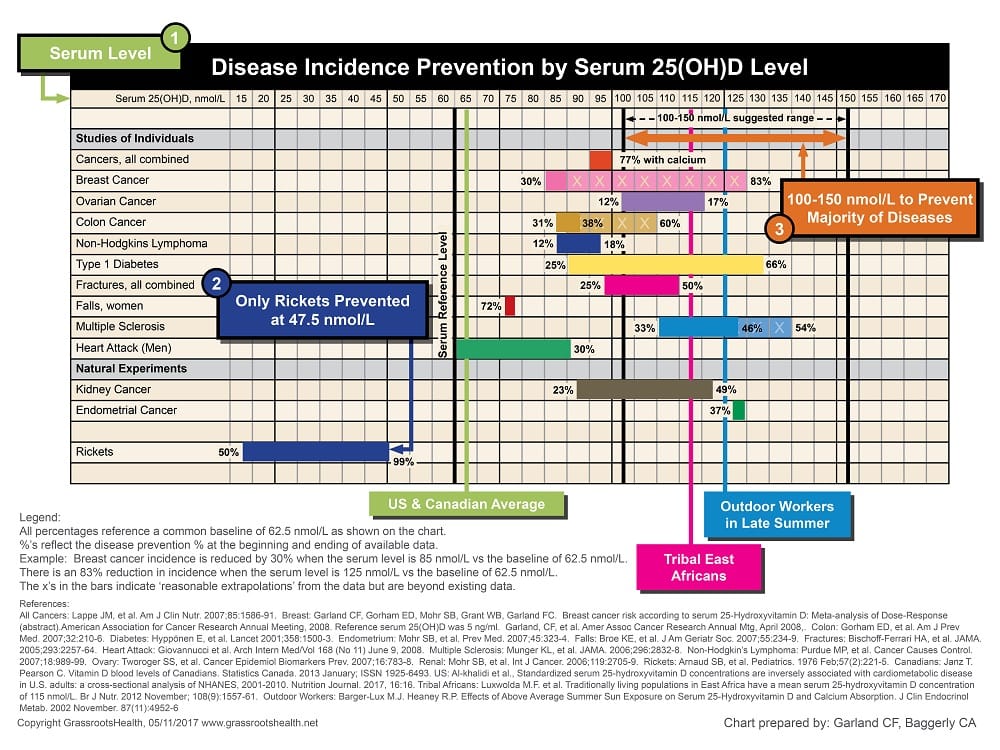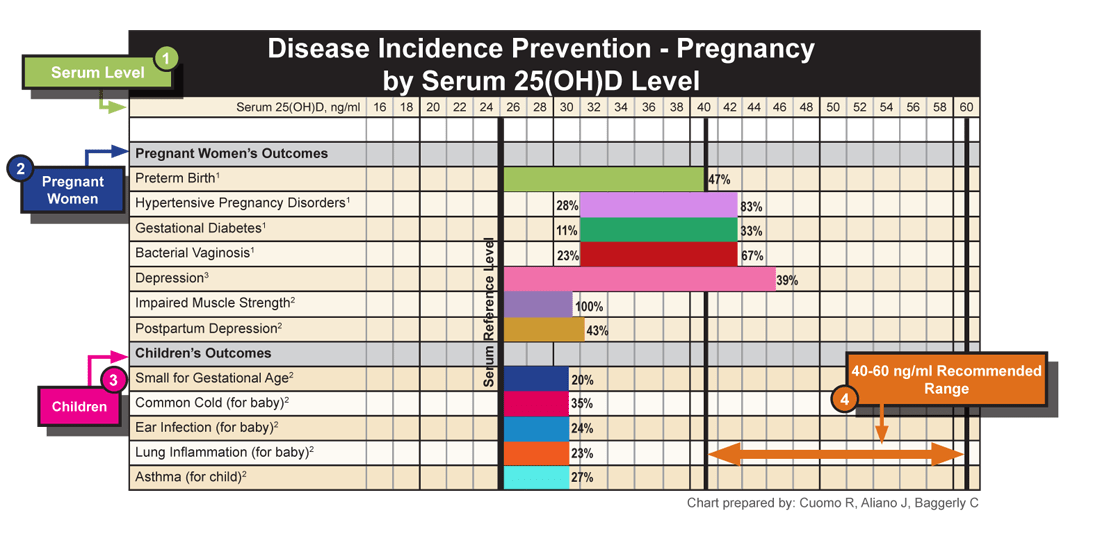Published on February 25, 2019
Today we wanted to give you a blog that is meant for someone new to vitamin D. For most of you on our subscription this is old news – so we ask for you to share it with someone who might find it new and useful for them!
Scientists have found that most of the world is vitamin D deficient
 If you are new to our newsletter you are most likely vitamin D deficient, as the average person in the US has a vitamin D serum level around 25 ng/ml. In today’s world it takes effort to get within the recommended range of 40-60 ng/ml because most people are predominantly inside; use sunscreen when outdoors; rely on multi-vitamins with low dosage of vitamin D (due to incorrect RDA); and cannot get enough from food.
If you are new to our newsletter you are most likely vitamin D deficient, as the average person in the US has a vitamin D serum level around 25 ng/ml. In today’s world it takes effort to get within the recommended range of 40-60 ng/ml because most people are predominantly inside; use sunscreen when outdoors; rely on multi-vitamins with low dosage of vitamin D (due to incorrect RDA); and cannot get enough from food.
Why is the RDA too low? Why is milk not enough?
The US RDA is too low because the Institute of Medicine (IOM) made an error in their analysis of the scientific data when they adjusted the RDA in 2010 and, their focus was entirely on bone health, not cancer, not diabetes, not pregnancy. We have initiated a petition to encourage the IOM and Health Canada to review the guidelines based on a paper describing their error as well as the need to get current with the new findings. Suffice it to say that governments have not yet caught up with the published science. When talking to your doctor do not be surprised if they think 20 ng/ml is enough, or if they discourage you from taking over 2000 IU/day of vitamin D supplementation. Please take them a copy of our Scientists’ Call to D*action showing the recommendation from 48 vitamin D researchers to aim for a 40-60 ng/ml target range (100-150 nmol/L).
 The government first supplemented milk with vitamin D to prevent rickets. Rickets is a disease caused by a lack of sunlight (resulting in a lack of vitamin D production) which leads to softening and weakening of developing bones in young children. It was prevalent in the early 1900s as people moved from farms to the cities and got less and less sunlight. Children with vitamin D levels less than 20 ng/ml are at risk for rickets. This is a serious problem and to best supplement all children the government decided to fortify milk (and some breads). It worked! Despite the fact that a vitamin D level of 20 ng/ml is enough to prevent rickets in children, it is not enough to support overall good health throughout our lifetime.
The government first supplemented milk with vitamin D to prevent rickets. Rickets is a disease caused by a lack of sunlight (resulting in a lack of vitamin D production) which leads to softening and weakening of developing bones in young children. It was prevalent in the early 1900s as people moved from farms to the cities and got less and less sunlight. Children with vitamin D levels less than 20 ng/ml are at risk for rickets. This is a serious problem and to best supplement all children the government decided to fortify milk (and some breads). It worked! Despite the fact that a vitamin D level of 20 ng/ml is enough to prevent rickets in children, it is not enough to support overall good health throughout our lifetime.
Why do I need more?
To understand why the amount necessary to prevent rickets is not enough for overall good health, you need to understand more about vitamin D and how it affects your body. Vitamin D is actually a hormone that affects over 3000 cell processes within your body. Without enough vitamin D circulating regularly in your blood, your body simply does not function as it was intended (ridding the body of intruders, fighting disease, repairing cells, etc.). This presentation from Michael F. Holick, PhD, MD – “D-Lightful Vitamin D” is a great introduction to how vitamin D affects your body’s systems.
Around the 1960s scientists started doing studies on vitamin D and disease prevention. While these studies are not as prolific as the studies on bone health, there are many that have found that vitamin D serum levels well above 20 ng/ml, in the range of 40-60 ng/ml, are necessary to prevent a number of diseases and cancers. Some of these studies have been randomized control trials (RCTs) and others have been epidemiological studies (looking at trends to determine cause and effect). GrassrootsHealth put together this chart to show the relationship between vitamin D levels and disease prevention.
In the past ten years, there have been some successful RCTs that showed how beneficial vitamin D supplementation is with pregnant women. Please see this disease incidence prevention chart for pregnancy and children.
I have a specific condition, can vitamin D help me?
GrassrootsHealth, working with over 40 leading vitamin D scientists, has amassed many videos (from conferences, webinars and interviews) that can explain in more detail how vitamin D can prevent a certain disease. Please consult this chart for the video that might be pertinent to you or your family.
Condition |
Video Link |
| Cancer | |
| Diabetes | |
| Pregnancy | |
| Colds & Flus | |
| Cystic Fibrosis | |
| Alzheimer’s Disease | |
| Autism |
OK, I’m convinced. Now what do I do?
The first thing to do is test your vitamin D level. You may check with your doctor for a test or join D*action. With D*action you will be asked to pay for a test kit of your choice that includes vitamin D and complete an online questionnaire to enroll in our study and share your data for our analysis. Then you will receive the kit and instructions in the mail. You will prick your finger and put blood on the blood spot card(s) and return it to us. A couple of weeks later you will receive a link via email to view your vitamin D serum level and other results included as part of the kit you purchased. We recommend you test your blood level every 6 months, especially when you are new – as you will most likely be changing your habits and/or diet to achieve a higher serum level. Doing this through D*action will help provide us with more data and help fund vitamin D research and education.
Right NOW is a perfect time to test your level (it’s been a dark, cold winter, and you’re about as low with your serum level as you will be for the year).
How can I track my vitamin D intake and level?
To help you track your vitamin D levels, GrassrootsHealth has created an online tracking system called myData-myAnswers. This will help you know how your supplementation and intake may be affecting your vitamin d levels and impacting your health. Check it out today!










